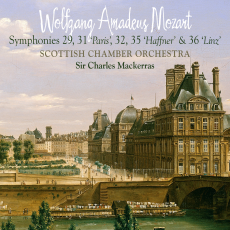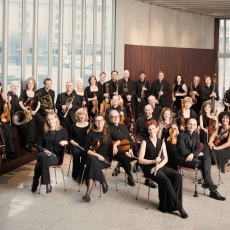Mozart Symphonies 2 - SCO & Sir Charles Mackerras - Classical Source
This release makes a welcome partner to Sir Charles Mackerras's set of the late Mozart symphonies. That two-CD presentation included superb performance of symphonies 38, 39 and 41 (but a less impressive No.40) and the new group of interpretations is on that same high level. There is a fullness of sound here that does not preclude admirable detail; a quality that gives the performance of 18th-century music on modern instruments (albeit with natural horns and trumpets) a good name.
Symphony No.29 is played firmly and strongly; far larger in scale than many a performance and the expansive phrasing plays a big part in giving this impression. One unclear area concerns the matter of whether continuo is necessary. There does not seem much need for harpsichord but perhaps a bassoon would have helped the lower lines (Hogwood and others use one). Mackerras has a fine sense of structure - Allegro moderato is the marking for the first movement and it is ideally unhurried, both halves are repeated and yet the movement does not seem at all overlong. Balance is consistent and there is no underlining of melodic phrases - the very opening is typical - all the lines are audible but where most conductors stress the falling motif in the strings, Mackerras leaves the fully harmonised inner parts clearly audible and the listener must decide where, in this very gracious passage, the main theme lies. On the repeat, the violin line is a little more pointed - a deliberate intention or is it merely how the conductor chose to express the music at those moments? Throughout, woodwind detail is exceptionally clear and the high horn-writing is made to sound exciting, especially in the finale.
The Paris Symphony is given with both its original slow movement and the revised version. Other recordings have sometimes included the brief revision but they place it at the end, Mackerras has both set between the outer movements but the listener can of course programme the CD player for the movement of choice. To play both one after the other has no musical merit. Critics have never liked the second version but it is a pleasant piece, it matches the mood of the work quite well and responds to Mackerras's light touch. The first movement is given suitable grandeur and the finale sparkles at an appropriately rapid speed. I always recall Karl Böhm's enormously slow tempo here - anyone whose first experience of the music was with this conductor's well-thought-of version will be amazed at Mackerras, yet for some reason, whether very fast or very measured, either tempo seems to work.
No.32 is given a splendid reading - powerful and driving. There is an interesting sonic effect that catches the ear (evident also in symphonies 31 and 35) where often the timpani stress the first note of a roll thus grabbing the attention but without the drum sequence being over prominent. It is also a bonus to have the central slow section taken at a flowing speed - so often this can be made sluggishly romantic - and the clarity of the interestingly high horn parts in the fast final section makes for attractive colouration.
In the ‘Haffner' Symphony I must take issue with the informative booklet note. We know that Mozart originally wrote the work for Sigismund Haffner in 1782 and revised it in 1783 for a performance before Emperor Joseph II but in recounting those bare facts the given information implies that the final version is simply a re-orchestration of the same music. In fact the first version was in Divertimento form with five movements plus a March. Mozart left out a Minuet when revising and none of this is mentioned. Additionally we are told that in his revision Mozart added flutes and clarinets to the score (perfectly true) but more controversially the note suggests that Mozart cancelled the two repeats in the first movement. This seems highly unlikely. True the repeats have been lost somewhere along the way but it is very doubtful if Mozart sanctioned this. The Ricordi score retains them (and conductors such as Fricsay, Szell and Salonen observe the first of them in their recordings). Many years ago I saw a very early publication from around 1800 in which the repeats were included (regrettably I did not have enough money to purchase it).
I do not criticise Mackerras for playing what is in the score but it does result in a five-and-a-half minute first movement and, with all repeats, an eight-minute second movement. I certainly admire the power afforded the opening: a noble commencement driving purposefully forward with excellent woodwind detail. There are many recordings and to name some of the rarer but outstanding examples that provide similar impetus, Eduard van Beinum, Hans Schmidt-Isserstedt and Karl Ristenpart come to mind. With Mackerras the splendid detail and great clarity of the Andante is memorable - ideal tempo, ideal balance and immensely sensitive phrasing. It is a habit of some musicians (and one I never welcome) to leave out the last two notes of a minuet, finishing on the last main chord at the start of the final bar and leaving out the two remaining ‘tick-tock' notes. This often happens with the ‘Haffner' Symphony - not a serious omission but I always prefer to hear those notes. With Mackerras there is a bigger surprise, not only are the final two notes missing but neither are they played before the Trio. This leaves a most uncomfortable gap - could it possibly have been the editor's mistake rather than the conductor's will? I have always admired Mackerras's thorough attention to detail and faithful respect of eighteenth-century style - this omission is not at all characteristic of his usual approach. Doubts are thrust aside when reaching the whirlwind finale - speed, detail, excitement - they are all there.
The conductor's view of the ‘Linz' Symphony has not much changed since he first recorded the work for Classics for Pleasure in 1973 with the London Philharmonic. The only noticeable difference lies in the Minuet which is rather faster and, as in all the relevant symphonies in the current set, he now takes both repeats after the Trio as well as before. The sound is a little less 'present' in this work and I am not sure whether to attribute this to the engineer or to Mackerras choosing to give lighter impact to the forte chords. Symptomatic of this, the clear colouring of timpani tone on impact is less than in the other fully-scored symphonies (although the balance of these instruments remains natural). Perhaps surprisingly, the 1973 analogue recording seemed to feature greater dynamic contrast but this is still is a fine large-scale reading with magnificent string-playing from the Scottish Chamber orchestra in the finale.
Hopefully Linn will record still more Mozart symphonies with these artists. The realisation of convincing Mozart style in this current release makes it an attractive prospect.
From classicalsource.com


